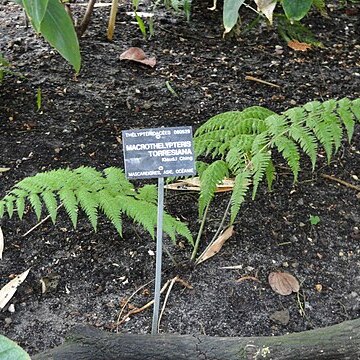Rhizome short, creeping or suberect; scales narrow, ± thickened, at least near their bases, with marginal and superficial acicular and/or capitate hairs. Lamina 2-pinnate to 3-pinnatifid; pinnules ± adnate to pinna rachis; rachis and costa with scales and/or hairs; scales pallid, hair-pointed, with or without ciliate margins (scales lacking in M. torresiana); hairs slender, multicellular and acicular, or unicellular and acicular or frequently capitate. Sori small, indusiate or (not in Australia) exindusiate; indusium small, persistent but often eclipsed by mature sporangia, bearing short capitate hairs; sporangia with short, capitate hairs near the annulus. Spores with a very fine surface reticulum (not visible by light microscope), and slight wings.
Caudex short, creeping or suberect; scales (also on base of stipe) narrow, ± thickened at least near base, with marginal and superficial acicular and/or capitate hairs. Lamina bipinnate-tripinnatifid with ± adnate pinnules; lowest pinnae little reduced; scales on rachis and pinna-rachis narrow, pallid, thickened at base and sometimes wholly terete, with or without marginal hairs; hairs on surface of frond slender and acicular or short and capitate, some long multicellular hairs always present. Sori always small, usually with a small but persistent indusium often hidden by mature sporangia; sporangia bearing capitate hairs; spores with a very fine surface reticulum not resolvable by light microscope, and slight wings.
Stems short-creeping, thick, 1 cm diam. Blades 2-pinnate-pinnatifid nearly throughout, broadest at base, apex gradually reduced; pinnae pinnate-pinnatifid, sessile or stalked, not connected by wing along rachis; costae not grooved adaxially; buds absent; veins free, often forked, tips not reaching margin; rachises and costae lacking scales; indument abaxially of unbranched, septate hairs mostly over 1 mm. Sori round, medial to supramedial; indusia small, less than 0.3 mm diam., often obscured in mature sori; sporangial capsules bearing short-stalked glands. x = 31.

